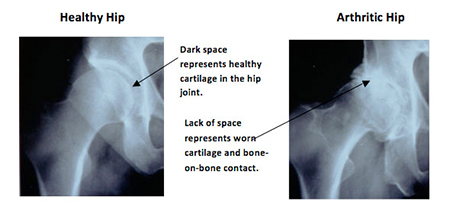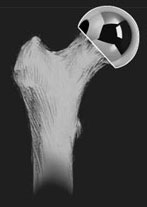Hip Resurfacing
An increasingly common alternative to total hip replacement is called hemi-resurfacing. Many surgeons consider this a more conservative procedure that can be less invasive than traditional total hip replacement.
Femoral head resurfacing utilizes a high-strength metal (cobalt chromium) cap that resurfaces the head of the femur and does not require a long metal stem or a socket replacement like total hip replacement.
This conservative procedure makes the technique less invasive than traditional hip replacement surgery. This technique allows for a smaller incision and less bone removal, which can allow you to recover more quickly and with less pain.
The implant can also help prolong or avoid the need for future total hip replacement. However, if you should need total hip replacement in the future, femoral head resurfacing allows your surgeon the ability to perform the procedure with a less-invasive approach.

Benefits of Hip Resurfacing
- Eliminate or reduce pain
- Less scar tissue
- Less removal of tissue and bone
- Quicker mobility
- Shorter hospital stay
- Smaller incision
- Shorter recovery period
- Improve quality of life
- Return to normal activity
- Low-impact sports and activities
Hip resurfacing is one option available to you and your surgeon. Only your orthopedic surgeon can determine if you are a candidate for this implant or if another type of implant would better suit your unique situation.
Hip Resurfacing Complications
While uncommon, complications can occur during and after surgery. Some complications include infection, blood clots, implant breakage, malalignment, and premature wear. Although implant surgery is extremely successful in most cases, some patients still experience stiffness and pain. No implant will last forever and factors such as the patient’s postoperative activities and weight can affect longevity. Be sure to discuss these and other risks with your surgeon.
Preparing for Hip Resurfacing Surgery
Patients should begin preoperative strengthening exercises to help them prepare for surgery and their recovery. Patients may be given a comprehensive nutrition plan to help ensure optimum health before surgery.
There are many things that your surgeon may do to minimize the potential for complications. Your surgeon may have you see a medical physician before surgery to obtain tests. You may also need to have your dental work up to date and may be shown how to prepare your home to avoid falls.
 After Hip Resurfacing Surgery
After Hip Resurfacing Surgery
After surgery, you probably will be hospitalized for 2 to 3 days. During this time, you will receive pain medication and begin physical therapy. It is important to start moving your new hip as soon as possible after surgery to promote blood flow, to regain hip motion, and to facilitate the recovery process. You should be out of bed and walking with crutches or a walker within 24 hours of your surgery. You will be assisted in and out of bed, and you will use support devices such as cane while you are walking.
Before you leave the hospital, your therapist will show you a variety of exercises designed to help you regain mobility and strength in your hip. You should be able to perform these exercises on your own at home. You will be shown how to safely climb and descend stairs, how to get into and out of a seated position, and how to care for your hip once you return home.
At home, it is important to continue with your exercises as your physician has instructed. It is a good idea to enlist the help of friends or family to help you once you do return home.
Hip Resurfacing Recovery
Every person’s recovery time will vary, but most people should be able to drive 1 to 2 weeks, garden after 3 to 4 weeks, and golf about 6 to 8 weeks after surgery. Your surgeon will tell you when you can return to these activities and will also tell you which activities to avoid.
You will typically not be allowed to participate in high-impact activities or contact sports. These types of activities place extreme pressure on the hip joint, which could lead to complications.
All patient education materials are provided by OrthoPatientEd.com and have been reviewed by our Advisory Board of leading Orthopedic Surgeons to ensure accuracy. All materials are provided for informational purposes only and are not intended to be a substitute for medical advice from your orthopedic surgeon. Any medical decisions should be made after consulting a qualified physician.
This site includes links to other websites. OrthoPatientEd.com takes no responsibility for the content or information contained in the linked sites.

